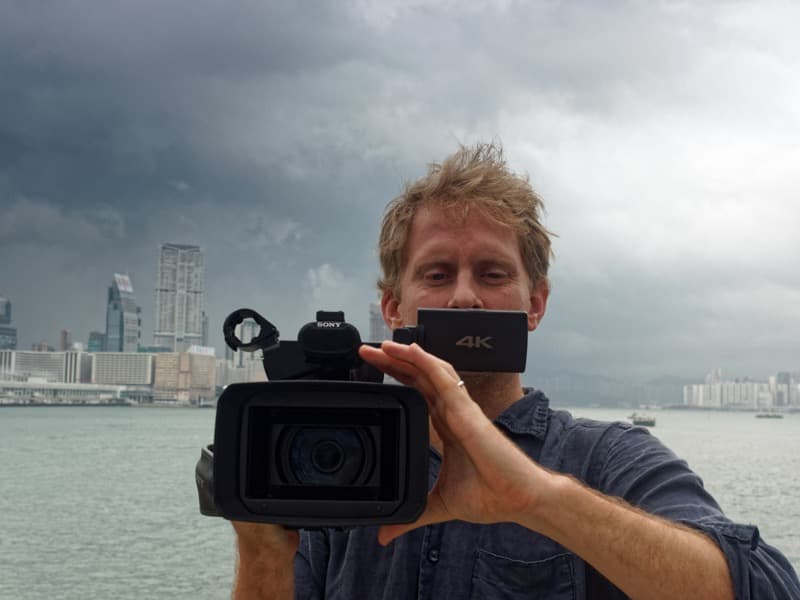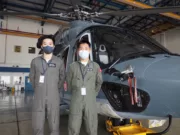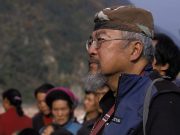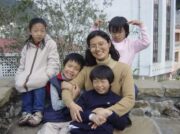An Eye for the Storm

As Super Typhoon Dujuan slammed into northeast Taiwan late on 28 September 2015, most people in the area were at home, sheltering from the raging winds and rain. It was hardly a night to be out and about, yet James Reynolds – who lives in Hung Hom, Hong Kong – was in an alcove next to the railway station near the coast in Su’ao Township, filming as debris rushed and crashed by.
Just behind him, keeping an eye out for additional danger, was Reynolds’ friend Mark Thomas, who noticed metal roofing sheets smash so hard into concrete just outside that sparks flew. Branches of trees were swept past as the wind roared, rain squalls were so fierce there were whiteouts with visibility below four metres.
“Dujuan was in the top three strongest typhoons I’ve filmed,” Reynolds later tells me, which is saying something given that, at just 32, he’s a veteran of “chasing” and filming typhoons. While storm chasing is not unusual in the US, Reynolds is a pioneer of travelling to experience typhoons – the Pacific equivalent of hurricanes or cyclones – and with Dujuan he notched up his 51st chase.
In a decade of typhoon chasing, Reynolds has turned what began as a hobby into a business, nowadays appearing on global news reports, and licensing footage for productions ranging from wild weather documentaries to screwball disaster movie Sharknado. Not content with heading to storms most people wish to avoid – including Haiyan, which killed over 7300 people in the Philippines two years ago – he has added volcanoes to his specialities, flying off to film as incandescent ash clouds raced down slopes towards him, or a quivering lava dome threatened to disintegrate and obliterate the surrounds including Reynolds plus trusty camera, tripod and all.
Fascinated by the strongest winds on earth
Reynolds grew up in Gloucestershire, southern England – hardly a place for nature’s extremes, though he remembers loving autumnal storms and, “Lying in bed listening to the wind and rain. It was a very comforting feeling.”
His father was an airline pilot, and the family made the most of perks enabling cheap tickets, including travelling to Australia with stop-offs in Asia. “I got captivated by this part of the world,” says Reynolds. In his late teens, he set off on what was supposed to be a round the world trip but spent most of the time in southeast Asia – Thailand, Vietnam, and Cambodia, riding scooters and enjoying cheap beers on the beach.
Then, as a “ticket” back to Asia, Reynolds studied Chinese at Edinburgh University, Scotland. The course included a year in Shanghai, plus time in Taiwan. “I was in Taiwan during July and August, and it was clobbered by two very intense typhoons,” recalls Reynolds. “It was my first taste of extreme weather, and my expectations were totally off. I expected crazy raging wind, but there were strong outer bands in Taipei, and I got the idea about typhoons, including that as you get closer to the centre, winds increase exponentially in strength. I was fascinated, including about getting into the eye of a storm, to see what it’s like, experience the strongest winds on earth.”
After graduating, Reynolds headed for Shanghai, and landed work with a television production company. He found it a fun, interesting job – helping make documentaries and news stories, while learning about the production process. Reynolds’ first solo chase was in September 2006 when, equipped with just a basic handicam, he travelled from Shanghai to near Da Nang on the coast of Vietnam. “It was quite expensive, and I stressed about the cost of the trip,” he says. “But it seemed the right thing to do –it was unusual and interesting. I blundered in with no idea of what to expect, assuming the storm would come to me based on the Joint Typhoon Warning Center information. I went to a hotel, and waited, with my dad sending text message updates.”
The hotel was one of the tallest buildings in a small town, and Reynolds went to the covered roof to watch the typhoon come in. He found it amazing watching as the wind blew, with intense rain, windows shaking, big gusts as the area was clipped by the storm’s southern eyewall. While some tourists were almost abusive to Reynolds, yelling, “What are you doing on the roof?” the hotel staff gave him a gift as he left, and thanked him for keeping them updated on the typhoon, which they’d underestimated.
The typhoon, Xangsane, caused extensive flooding and 71 deaths in Vietnam. Reynolds was quite shocked to see damage, especially from the storm surge which had dumped sand over the main coastal highway. Walking through knee deep floodwaters, he filmed a row of seafront buildings that had collapsed, and a big radio tower that had fallen on someone’s house.
Soon afterwards, a German company that was making a documentary on typhoons asked to use some of the footage. They paid £250, and though Reynolds realised there could be a way to monetise his hobby, he thought this would be a one off.
They next year, 2007, Reynolds says, “I got into really meaty storms, and some things blew my mind. I realised documenting this stuff was really interesting and important.” One of these storms was Typhoon Sepat, which hit central Taiwan in mid August. Though Reynolds experienced the most powerful, eye wall winds, he was most impressed by seeing the immense water runoff, particularly at the foot of a gorge where a normally placid river had been transformed into a surging brown torrent.
The next spring, he was interviewed about Sepat for Discovery Channel’s Raging Planet series. The interview was in Taiwan, and was coincidentally delayed by a typhoon. Reynolds filmed on his handicam, rated the footage “dreadful”, and decided, “I’ve got to get a decent camera to do this.” He bought a basic video camera, gave himself the moniker “typhoonhunter”, and set up a youtube channel. At the time, he felt no one in the west really cared about typhoons, they were not on the media radar. But he licensed more footage to documentaries, and in 2009 – spurred by him joining Twitter – news agencies started knocking on the door, and he appeared on segments for the Weather Channel and CNN.
In early 2009, Reynolds moved to Hong Kong with wife Yoki, a Chinese woman who grew up in Japan, and whom he’d met during the language course. He began working hard at marketing his footage. Yoki was initially sceptical whether he could make a living of typhoon chasing, but now appreciates that he’s a rare person who does something he loves as his job – and trusts that he knows how to protect himself. So, is she also keen on experiencing typhoons? “I have no interest in chasing storms or volcanoes,” Yoki says. “I prefer visiting the locations he goes when the sun’s shining.”

But Reynolds did find a frequent partner in his escapades – Briton Mark Thomas, a Taipei based businessman who shares a fascination for natural phenomena and love of travelling. They met at the Mayon volcano on the Philippines, got on really well and discovered their common interest. “One of the weird things about James and I is that we have almost the exact same level of danger/safety awareness,” says Thomas [or “Thomas wrote in answer to questions via Facebook”], adding, “A chase is only 20% about the ‘phoon or the ‘cano. Mostly, we just have loads of laughs & share quite a few beers.”
While Reynolds seeks safe places during typhoons – “which basically means lots of concrete” – he is keenly aware they are dangerous, and has long aimed to be mentally prepared to witness devastation. Even so, he was shocked to film a man being swept to his death. The incident was all the more startling as it was during fine weather, with Reynolds filming huge waves created by a nearby storm, as they pounded a craggy headland on one of Japan’s Ryukyu Islands. A fisherman walked into the frame, went briskly down a steep path, set down his gear, and seconds later was swamped by a wave, with Reynolds unable to do anything but yell to nearby people who had no chance of helping.
The next year, Reynolds was filming as waves hurtled through a harbour in Taiwan. Seeing a fisherman panic and leap from his boat, then struggle in the swell, he ran forward – camera still rolling – and pulled him to safety. “He needed a hand,” says Reynolds. “My mantra is: If you do what I do, you need to have a positive effect on communities where you’re filming. They’re having a really bad day, and if you can help out – great.”
Despite this, storm chasers like Reynolds can face criticism, particularly for heading to places that may face death and destruction from the storms they relish.
Typhoon Haiyan, southern Philippines: scary, hard to imagine
After intercepting Typhoon Haiyan in the southern Philippines, and the storm killing over 7300 people, Reynolds wondered, “Am I a ghoul going in?”
But on later returning to the worst hit town, Tacloban, he and Mark Thomas were welcomed. The hotel had strung up a banner: “Welcome to the Typhoon Team”.
They found people appreciated their efforts, felt they’d filmed the storm well, and got footage out quickly. A doctor said, ” Thank you, guys. We knew it was bad, but it was not until we saw the footage that we really grasped how catastrophic it was.”
Typhoon Haiyan had looked set to be powerful even as Reynolds left Hong Kong in early November 2013. He and Thomas, along with US storm chaser Josh Morgerman, first booked into a hotel by the shoreline. But checking online information, they realised this may not be safe. “We were seeing images no one had seen before in the modern satellite era,” says Reynolds. “There was a forecast of 170 knot winds, crazy shit like that. Twitter was abuzz with meteorologists saying this was one of the strongest storms in recorded history.”
The trio warned people including hotel staff of impending danger, and found another hotel at least two blocks inland, maybe five metres above sea level. They spent a night there with Haiyan approaching, but even as dawn broke on 8 November the winds were still little more than breezy. Then, abruptly, the core of Haiyan arrived. Reynolds filmed from a balcony as wind and rain lashed neighbouring rooftops; soon water was pouring down a hotel stairwell. The situation became scary, hard to imagine, as the surroundings were inundated with brown water that was knee high, and rising. The ground floor of the hotel was transformed from sanctuary to potential death trap, with some people trying to escape rooms, others arriving from outside. The three storm chasers became impromptu rescuers, carrying a wheelchair bound man up a flight of stairs, and wading through waist deep water to guide others to safety, including two who were on mattresses like floating stretchers.
Reynolds filmed as best he could, helped people, warned Thomas to be careful of debris in the filthy water. But unseen metal caught Thomas, penetrating his ankle and ripping a gash into his lower leg. Suddenly, he was among casualties of the storm.
The typhoon’s onslaught was over by late morning, when Reynolds could see the devastation wrought by the storm surge, and knew immediately there was a mega-catastrophe. He filmed debris filling streets between ruined houses, people finding bodies amongst the wreckage, a man tossing a bowl of water at a shop turned raging inferno.
Luck was on the trio’s side, as the Philippine Army set up a command post close to the hotel, and they were evacuated by helicopter and then a flight from Tacloban. Thomas, whose main wound was already starting to rot, received treatment. “The doctor said if there were another 24 hours with no medical care, he would have lost his leg,” says Reynolds.
Reynolds had felt some detachment about what he saw and filmed. The emotional impact came later, especially on a later visit when he went to a graveyard, saw pictures of kids and stuffed toy bears. “Mass graves were the worst,” he says.
As well as covering Haiyan for news agencies, licensing footage and recounting his story for documentaries, Reynolds has given Haiyan footage to over 50 charities and other organisations, hoping it can forewarn people should similar storms threaten. His shots from Haiyan and other typhoons were crucial to a short film on typhoon hazards I helped make for Hong Kong Observatory, on behalf of the Typhoon Committee of the World Meteorological Organization.
Going after erupting volcanoes
Filming volcanoes was for Reynolds a logical extension to storm chasing. “With so many amazing volcanoes almost on the doorstep, it would seem silly not to go after them,” he says. “Volcanoes interest me as much as if not more than typhoons do, and to see a full eruption is quite rare. They’re scarier than typhoons, though, with a lot more opportunity for things to go wrong.”
In October 2010, he headed to Central Java, where Mount Merapi – Fire Mountain – was in the midst of multiple eruptions that killed over 300 people. He shot steam and ash being blasted from the summit crater, along with a nearby city and village coated in ash. Krakatoa was also “popping” at the time, and Reynolds spent a day travelling there. He set up camp on a beach about 1.5 kilometres away, and filmed some of his best volcano footage yet, with ash and lava bombs exploding from the crater, looking grey by day, glowing red at night.
Two months previously, Reynolds and Thomas had gone to Mount Sinabung, Sumatra, after it had erupted for the first time since 1600. “We spent about five days there, and saw nothing,” he recalls. “But four years later, it really started cranking up, and we knew exactly where to set up, which hotel to stay in.”
On 21 January last year, Reynolds filmed as a monstrous ash plume billowed skywards, and pyroclastic flows raced down the volcano’s slopes. Pryoclastic flows are like avalanches of ash and rock, and with temperatures up to 700°C they are deadly to all in their path. The people killed by the eruption of Mount St 1980 included a photographer who was 13 kilometres from the crater; just 11 days after Reynolds filmed at Sinabung, a television journalist was among at least 16 people killed by an eruption.
Reynolds and Thomas had chosen their vantage partly as they could see locals were still farming nearby, and there were a couple of ravines between them and the volcano. Even so, there was a gentle rain of ash, and shots with a telephoto lens show foaming dull brown surf surging down barren slopes, and looming so large in the frame it looks barely an arm’s length away. “My heart was racing on one or two occasions,” says Reynolds. “You see a force like that, and can’t help but have your heart racing. It’s an amazing volcano.”
While Reynolds has filmed volcanologists abseiling into an active crater, he says, “I’m not interested in doing stunts myself; I’m interested in getting shots.” Even so, he often ventures where many people might tremble to tread. Like Paluweh, an eight kilometre wide volcanic island in eastern Indonesia. In November 2012, 196 people who lived on the volcano were evacuated to nearby Flores. A dome of lava began building in the crater, the volcano often puffed out ash, and on 3 February the next year an eruption blasted ash 14 kilometres skywards, creating an ash plume that eventually reached west Australia. Days later, Reynolds and Thomas arrived.
It was the rainy season, and with downpours and mists the intrepid duo only saw the volcano for two of the 48 hours they spent on Paluweh. But while mostly out of sight, the volcano was never out of mind. “There was an earthquake every 15 minutes – the whole mountain was shaking,” says Reynolds. They had a guide, who told Thomas about 70% of the whole island was on the lava chamber.
Reynolds wanted to film a pyroclastic flow going into the sea, and though he failed in this, he shot unique footage. Just before they were due to leave, Thomas had a last jog up the steep slopes, the others followed, the clouds cleared, and they looked over a ravine to the angry, active lava dome. This was a great bulge perhaps 100 metres high, with molten magma pushing upwards inside, covered in only a thin crust of hot rock that sometimes parted to reveal the glowing red core. Reynolds filmed the unstable, trembling steep slopes, which were steaming as if a fire raged within. Rock falls were frequent, with boulders bouncing and skidding downhill.
“I think it was the craziest place I’ve been – watching bits breaking off,” says Reynolds. “There always a chance of an explosion, and the mountain was shaking. It was like Jurassic Park up there.”
Even to the intrepid Reynolds, Paluweh was extreme. Asked if he’d go back to film, he responds, “I probably wouldn’t ever go near a dome like Paluweh’s again – that was scary.”
Earth Uncut TV – stock footage by James
Written for South China Morning Post magazine.
Top People
Helicopter crews brave mighty winds and waves to rescue seamen during South China Sea typhoons
On the morning of 2 July 2022, as Hong Kong was lashed by gales and rainstorms…
Maasai safari guide Jackson Looseyia
BAD-TASTE BLOOD My home village had about 15 people in it. What we think of as…
A Man for All Sequences Frederick Sanger
November 2013 saw the death of a man described by Craig Venter, among the pioneers of…
Blue light at last wins Nobel for LED titans
While the 2013 Nobel Prize in Physics was for an esoteric advance in knowledge — theoretical work…
Genius of the Jungles: Alfred Russel Wallace
Recently came news of a study finding that the distribution and evolution of Galapagos wildlife have…
The butterfly and the remarkable Professor Hofstadter
This spring, there was excitement in the world of physics as a long-predicted butterfly was proved…
James Hansen Godfather of Climate Change retires yet will be very busy
This month [April 2013], climate scientist Dr. James Hansen retired as head of NASA’s Goddard Institute…
Pan Wenshi: Scientist Who Fights for the Pandas
In a cave near a tributary of the Youshui River, Pan discovers Jiao Jiao, an eight-year-old,…
Jill Robinson helping bears
First Jill Robinson was shocked, then she set out to stop the suffering The Great Bear…
Jessie Yu – Hong Kong Single Parents Assoc founder
The best way to get ahead, says this tireless Hong Kong philanthropist, is to help yourself.…
Keeper of the Kings: Captive breeding Philippine Eagles
One man’s perseverance offers hope to a critically endangered bird of prey On a warm, sunny…
Dr Yang Lihe helping former leprosy patients
Dr. Yang Li-he has spent his life helping cure leprosy. Now he is helping former patients…
Dinosaur hunter Dong Zhiming
Unearthing China’s Real Dragons Dong Zhiming, 26, walked atop a low cliff of red and yellow…
Dramatic rescue by brave helicopter crew from roof of blazing Garley Building in Kowloon
Captain Mike Ellis eased the Sikorsky Blackhawk in towards the beleaguered, 16-storey Garley Building, in the…
Mountain Dog and rebuilding schools in China
I’m at a charity ball in Hong Kong, seated among a hundred guests in a bright…
Mother Ko’s fight for justice
The more lawmakers ignored her, the more determined she became to seek justice On a grey,…
SARS doctor and heroine Yannie Soo
A mysterious illness was striking the medical staff down one by one. How could they fight…
Allen Lien
In October 2002, boxes of clothes began arriving in Burkina Faso, a country in West Africa,…
Teacher Lin helps kids in Taiwan
Teacher Lin has a dream, in which more and more needy children find their home sweet…











